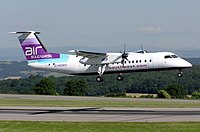Portal:Aviation
| Main page | Categories & Main topics |
|
Tasks and Projects |
The Aviation Portal

Aviation includes the activities surrounding mechanical flight and the aircraft industry. Aircraft includes fixed-wing and rotary-wing types, morphable wings, wing-less lifting bodies, as well as lighter-than-air aircraft such as hot air balloons and airships.
Aviation began in the 18th century with the development of the hot air balloon, an apparatus capable of atmospheric displacement through buoyancy. Some of the most significant advancements in aviation technology came with the controlled gliding flying of Otto Lilienthal in 1896; then a large step in significance came with the construction of the first powered airplane by the Wright brothers in the early 1900s. Since that time, aviation has been technologically revolutionized by the introduction of the jet which permitted a major form of transport throughout the world. (Full article...)
Selected article
Selected image
Did you know
...that in 1929 the Graf Zeppelin completed a circumnavigation of the globe in 21 days, 5 hours and 31 minutes? ...that during World War II, Marine Fighting Squadron 215 established four new U.S. Marine Corps records in the South Pacific including having the most ace pilots? ... that the airline Vildanden started its first route with wet leased aircraft from Coast Air?
General images -
In the news
- May 29: Austrian Airlines cancels Moscow-bound flight after Russia refuses a reroute outside Belarusian airspace
- August 8: Passenger flight crashes upon landing at Calicut airport in India
- June 4: Power firm helicopter strikes cables, crashes near Fairfield, California
- January 29: Former basketball player Kobe Bryant dies in helicopter crash, aged 41
- January 13: Iran admits downing Ukrainian jet, cites 'human error'
- January 10: Fire erupts in parking structure at Sola Airport, Norway
- October 27: US announces restrictions on flying to Cuba
- October 3: World War II era plane crashes in Connecticut, US, killing at least seven
- September 10: Nevada prop plane crash near Las Vegas leaves two dead, three injured
- August 6: French inventor Franky Zapata successfully crosses English Channel on jet-powered hoverboard
Related portals
Associated Wikimedia
The following Wikimedia Foundation sister projects provide more on this subject:
-
Commons
Free media repository -
Wikibooks
Free textbooks and manuals -
Wikidata
Free knowledge base -
Wikinews
Free-content news -
Wikiquote
Collection of quotations -
Wikisource
Free-content library -
Wikiversity
Free learning tools -
Wikivoyage
Free travel guide -
Wiktionary
Dictionary and thesaurus
Selected biography
Despite her surname, Jeana Yeager is not related to Chuck Yeager, the first man to break the sound barrier in level flight.
Selected Aircraft

The de Havilland Canada DHC-8, popularly the Dash 8, is a series of twin-turboprop airliners designed by de Havilland Canada in the early 1980s. They are now made by Bombardier Aerospace which purchased DHC from Boeing in 1992. Since 1996 the aircraft have been known as the Q Series, for "quiet", due to installation of the Active Noise and Vibration Suppression (ANVS) system designed to reduce cabin noise and vibration levels to near those of jet airliners.
Notable features of the Dash 8 design are the large T-tail intended to keep the tail free of propwash during takeoff, a very high aspect ratio wing, the elongated engine nacelles also holding the rearward-folding landing gear, and the pointed nose profile. First flight was in 1983, and the plane entered service in 1984 with NorOntair. Piedmont Airlines (formerly Henson Airlines) was the US launch customer for the Dash 8 in 1984.
The Dash 8 design had better cruise performance than the earlier Dash 7, was less expensive to operate, and more notably, much less expensive to maintain. The Dash 8 had the lowest costs per passenger mile of any feederliner of the era. The only disadvantage compared to the earlier Dash 7 was somewhat higher noise levels, but only in comparison as the Dash 7 was notable in the industry for extremely low noise due to its four very large and slow-turning propellers.
- Length: 107 ft 9 in (32.84 m)
- Wingspan: 93 ft 3 in (32.84 m)
- Height: 27 ft 5 in (8.34 m)
- Powerplant: 2× Pratt & Whitney Canada PW150A turboprops, 5,071 shp (3,781 kW) each
- Cruise speed: 360 knots (414 mph, 667 km/h)
- Maiden Flight: June 20, 1983
Today in Aviation
- 2012 – a Yemeni Air Force Antonov An-26, a twin-engine turboprop military transport aircraft, crashed in Sana’a, Yemen’s capital, resulting in the deaths of all ten individuals on board, including five military officers.
- 2012 – A ceasefire brings fighting in the Gaza Strip between Israel and Hamas to an end.
- 2012 – JetBlue Flight 1329: An Embraer E190, taxis to its gate after landing at Baltimore-Washington International Airport in Anne Arundel County, Maryland, a fire breaks out in one of its engines. After the airliner reaches its gate, everyone on board evacuates the plane uninjured via the jetway while firefighters douse the fire.
- 2004 – China Eastern Airlines Flight 5210, a Bombardier CRJ200, stalls and crashes near Baotou, China shortly after takeoff because of frost contamination; all 53 on board and two people on the ground are killed.
- 2003 – OH-58D Kiowa 92-0605 from D Troop, 1–17 Cavalry Regiment written off, reason unknown.
- 1990 – First flight of the Hongdu JL-8
- 1989 – A British Airways Boeing 747 narrowly misses crashing into the Penta hotel near Heathrow Airport
- 1986 – The first ever RAF air-to-air refuelling of a fully-loaded passenger carrying transport aircraft. It was carried out on a trooper flight to Oman as part of Exercise Saif Sareea. The refuelling took place over Sicily as part of the 4,200 mile, 9 h flight.
- 1981 – Aeroflot is banned from flying to the United States, after an earlier Aeroflot flight that overflew American military installations, straying from its supposed flight path.
- 1980 – Continental Micronesia Flight 614, a Boeing 727, crashes on landing at Yap International Airport; all on board survive.
- 1970 – US aircraft begin the first major bombing campaign of North Vietnam since 1968. 300 aircraft attack the Mu Gia and Ban Gari passes.
- 1959 – Ariana Afghan Airlines Flight 202, a Douglas DC-4, crashes after an apparent in-flight fire, killing 24 of 27 on board.
- 1958 – Fairey Gannet AS.1, WN345, fitted with Armstrong Siddeley ASMD.8 Double Mamba 112 coupled turboprop powerplant, suffers belly landing this date during test programme, caused by a partially retracted nosewheel. The pilot tries unsuccessfully to get the gear to deploy. Lands gear-up on foam-covered runway 22 at Bitteswell, suffering minimal damage. Repaired, it is back in the air within weeks.
- 1952 – First flight of the Percival Pembroke
- 1948 – The Roundel, the RCAF service publication, made its first appearance.
- 1947 – First flight of the Grumman F9F Panther
- 1917 – 21-24 – The Zeppelin LZ-104 "Das Afrika-Schiff" makes a 6,757 km journey through Africa in 96 hours (average speed 71 km/h).
- 1914 – Three RNAS Avro 504s bomb the Zeppelin sheds at Friedrichshafen.
- 1783 – In a flight lasting 25 min, de Rozier and d'Arlandes take the first untethered ride in a Montgolfière in Paris, the first human passengers carried in free flight by a hot-air balloon.
References
- Shortcuts to this page: Portal:Airplanes • P:AVIA






















































